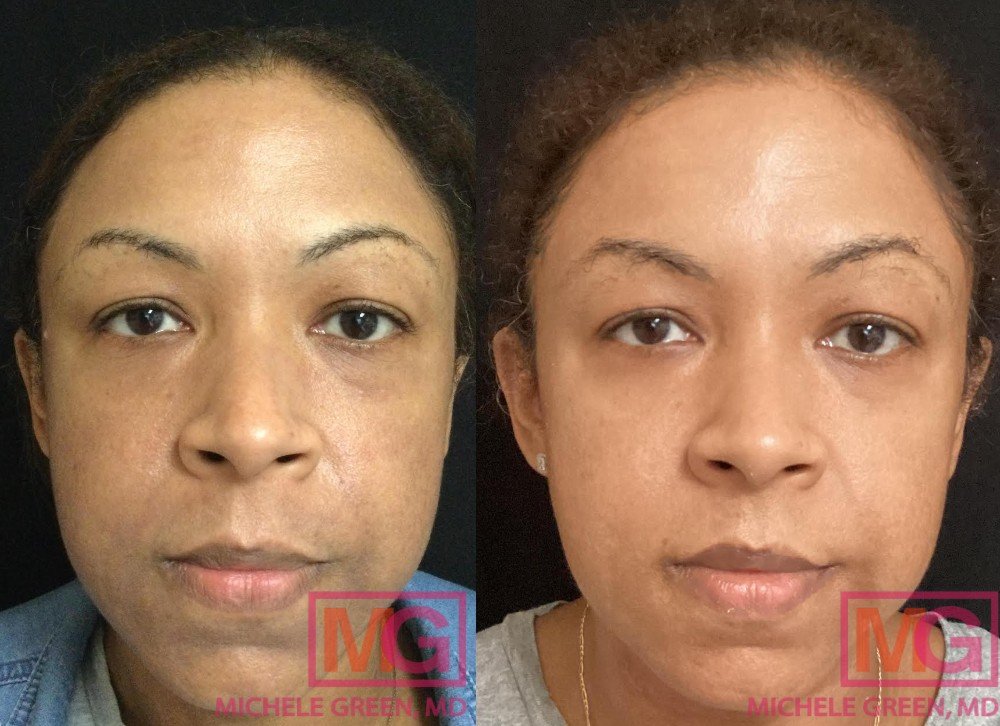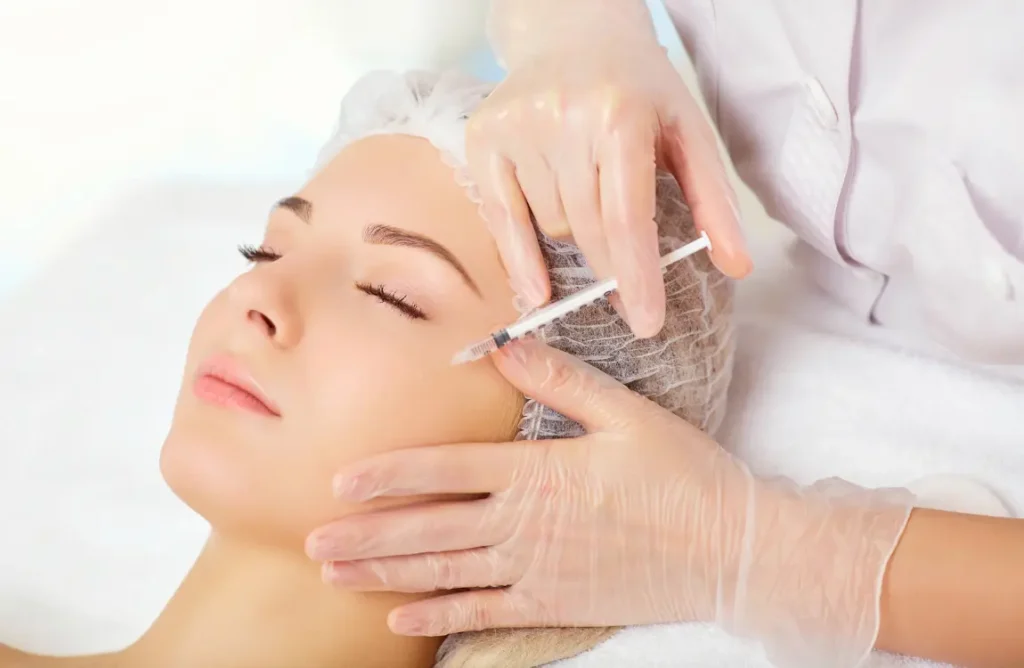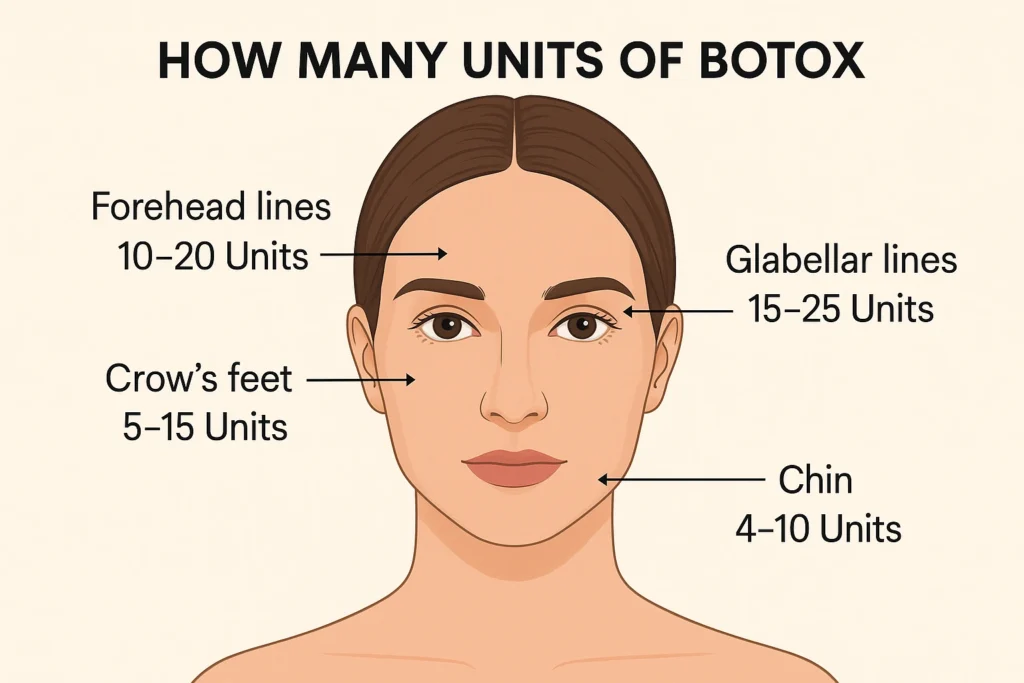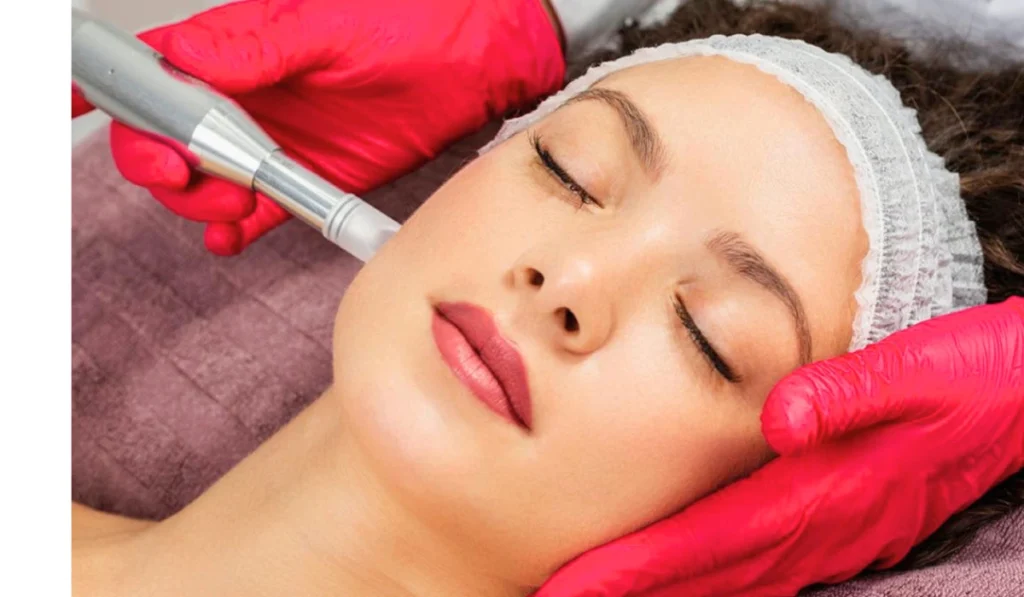Yes, microneedling can tighten the skin. It stimulates collagen production.
This helps improve skin texture and firmness. Microneedling, also known as collagen induction therapy, has gained popularity in recent years. Many people seek this treatment to address various skin concerns. But does it really help tighten skin? The procedure involves using tiny needles to create micro-injuries in the skin.
This triggers the body’s natural healing process. As a result, new collagen and elastin are produced. These proteins are essential for maintaining skin elasticity and firmness. In this blog post, we will explore the effectiveness of microneedling for skin tightening. We will discuss how it works, its benefits, and what to expect during the treatment. Stay tuned to learn more about this popular skincare technique.

Credit: qureskincare.com
Introduction To Microneedling
Microneedling is a popular cosmetic procedure. Many people seek it for its skin-tightening benefits. This technique involves tiny needles that create micro-injuries on the skin. These small punctures stimulate the skin’s healing process, promoting collagen and elastin production. Collagen and elastin are vital for maintaining firm and youthful skin. But how effective is microneedling for skin tightening? Let’s explore this innovative treatment further.
What Is Microneedling?
Microneedling is also known as collagen induction therapy. It uses a device with fine needles to create controlled skin injuries. These micro-injuries trigger the body’s natural healing response. The skin repairs itself, producing new collagen and elastin. This process can improve skin texture, reduce scars, and tighten the skin. The procedure is minimally invasive and can be done in a dermatologist’s office. It usually requires little to no downtime.
History And Evolution
The concept of microneedling dates back to ancient times. Early forms involved using plant thorns to puncture the skin. Modern microneedling began in the 1990s. Dr. Des Fernandes, a South African plastic surgeon, pioneered the technique. He used a fine-needle roller to treat surgical scars. Over the years, the technology has advanced. Today’s microneedling devices are more precise and effective. They offer better control over needle depth and treatment intensity. This evolution has made microneedling a safer and more accessible option for many people.

Credit: store.withdrnicole.com
How Microneedling Works
Microneedling is a popular skin treatment. It promises tighter, smoother skin. But how does it work? This process involves tiny needles. These needles create small punctures in the skin. These controlled injuries trigger the body’s healing process. Let’s explore this in detail.
Skin Structure And Collagen Production
The skin has three main layers: epidermis, dermis, and subcutaneous tissue. Collagen is a key protein in the dermis. It gives the skin structure and elasticity. As we age, collagen production slows down. This leads to wrinkles and sagging skin.
Microneedling helps boost collagen production. The tiny needles create micro-injuries. The body responds by producing more collagen. This process is called collagen induction therapy. The new collagen helps tighten and rejuvenate the skin.
Role Of Microneedles
Microneedles are tiny, fine needles. They range from 0.5 to 2.5 millimeters in length. These needles are attached to a handheld device. The device rolls or stamps the needles over the skin.
The needles create controlled micro-injuries. These injuries are not deep enough to cause damage. But they are enough to trigger the healing response. The body sends growth factors to the area. This leads to new collagen and elastin production.
The procedure is safe and effective. It can be done by professionals or at home with proper tools. Always follow safety guidelines to avoid infections or complications.
Skin Tightening Effects
Microneedling is a popular cosmetic procedure. It uses tiny needles to create micro-injuries in the skin. Many believe it helps with skin tightening. But how true is that? Let’s delve into the skin tightening effects of microneedling.
Scientific Evidence
Several studies back the skin tightening effects of microneedling. One key study found that microneedling increases collagen production. Collagen is a protein that helps keep skin firm. This study involved 20 participants. After four microneedling sessions, their skin showed significant improvement.
Another study examined the impact on wrinkles. It involved 10 participants aged 35-55. They had six treatments over 12 weeks. The results showed fewer wrinkles and tighter skin. The researchers concluded that microneedling is effective for skin tightening.
A table can help summarize these findings:
| Study | Participants | Sessions | Outcome |
|---|---|---|---|
| Study 1 | 20 | 4 | Increased collagen, firmer skin |
| Study 2 | 10 | 6 | Fewer wrinkles, tighter skin |
User Experiences
User experiences often align with scientific findings. Many users report seeing tighter skin after a few sessions. Some mention that the skin feels smoother and more youthful. Here are some common observations:
- Improved skin texture: Users feel their skin is smoother.
- Less sagging: Many notice a reduction in skin sagging.
- Fewer wrinkles: Some report that fine lines are less visible.
These experiences suggest that microneedling can be effective for skin tightening. But individual results may vary. Consistency and professional advice are key.
Additional Benefits
Microneedling has been gaining popularity for its skin-tightening benefits. But did you know it offers many additional benefits? Let’s explore some of these remarkable benefits that go beyond just skin tightening.
Reduction Of Wrinkles
Microneedling helps in the reduction of wrinkles. The tiny needles create micro-injuries in your skin. This process stimulates collagen production. Collagen is crucial for keeping your skin smooth and firm.
As more collagen forms, it fills in fine lines and wrinkles. This results in a more youthful appearance. The improvement is noticeable after a few sessions.
Improvement In Skin Texture
One of the standout benefits of microneedling is the improvement in skin texture. It addresses multiple skin concerns. This includes acne scars, large pores, and uneven skin tone.
After treatment, your skin feels smoother. Microneedling promotes new cell growth. This process helps in shedding old, damaged skin.
| Benefit | Details |
|---|---|
| Reduction of Wrinkles | Stimulates collagen production, fills fine lines |
| Improvement in Skin Texture | Addresses acne scars, large pores, uneven tone |
As you can see, microneedling offers much more than just tightening your skin. Its benefits extend to overall skin health and appearance.
Microneedling For Different Skin Types
Microneedling is a popular skincare treatment. It uses small needles to create tiny punctures in the skin. This promotes collagen production. The procedure can be beneficial for various skin types. Each skin type has its own concerns and needs. Tailoring microneedling to suit different skin types can yield better results.
Sensitive Skin
People with sensitive skin must approach microneedling with care. The skin may react more to the needles. It could lead to redness or irritation. Using a numbing cream can help. A skilled practitioner will use finer needles. This minimizes discomfort. It’s important to start with shorter sessions. Gradually increase the duration as the skin adapts.
Aging Skin
Microneedling can be very effective for aging skin. It boosts collagen production. This helps reduce fine lines and wrinkles. The skin looks firmer and more youthful. Regular sessions can improve skin texture. It can also address age spots and pigmentation. Over time, the skin regains its elasticity. This gives a smoother appearance.
Procedure And Aftercare
Microneedling is a popular treatment for tightening skin. It involves using tiny needles to create micro-injuries on the skin’s surface. This stimulates the body’s natural healing process, leading to firmer, smoother skin. But what does the procedure involve? And how should you care for your skin afterward? Let’s dive into the details.
Step-by-step Process
First, a numbing cream is applied to the treatment area. This helps reduce discomfort during the procedure. The cream usually takes 20-30 minutes to work.
Next, a microneedling device is gently rolled over the skin. The device has fine needles that create tiny punctures. These micro-injuries trigger collagen and elastin production. The process takes about 30 minutes, depending on the area treated.
After the treatment, a soothing serum is applied. This helps calm the skin and boost healing. The entire procedure can be completed in about an hour.
Post-treatment Care
After microneedling, your skin may appear red and feel sensitive. This is normal and usually subsides within a few days. Avoid direct sunlight and always use sunscreen. Sun exposure can damage the healing skin and affect results.
Keep your skin clean and moisturized. Use a gentle cleanser and a hydrating moisturizer. Avoid harsh products or exfoliants that can irritate the skin. Drink plenty of water to help your skin heal from within.
Follow any specific instructions given by your skincare professional. They may recommend products to enhance your results. Patience is key, as full results can take several weeks to appear.
Potential Side Effects
Microneedling is a popular cosmetic procedure known for its skin benefits. But, it’s important to understand potential side effects. This helps you make an informed decision.
Common Side Effects
Like any procedure, microneedling may cause some side effects. These are usually mild and temporary. Common side effects include:
- Redness: Skin may appear red for a few days.
- Swelling: Minor swelling can occur.
- Bruising: Some areas may bruise slightly.
- Dryness: Skin may feel dry and tight.
- Peeling: Light peeling is normal as skin heals.
How To Minimize Risks
Minimizing risks involves proper care and following guidelines. Here are some tips to help reduce side effects:
- Consult a Professional: Always seek a trained expert.
- Follow Pre-Procedure Guidelines: Avoid sun exposure and certain medications.
- Post-Care Instructions: Follow aftercare steps provided by your practitioner.
- Use Gentle Products: Apply mild skincare products post-treatment.
- Stay Hydrated: Drink plenty of water to aid healing.
By adhering to these tips, you can enjoy the benefits of microneedling while minimizing potential risks.
Microneedling Vs Other Treatments
Microneedling has gained popularity for its skin-tightening benefits. But how does it compare to other treatments? Let’s explore the differences between microneedling, laser therapy, and chemical peels.
Comparison With Laser Therapy
Laser therapy uses light energy to heat the skin. This stimulates collagen production. Microneedling, on the other hand, uses tiny needles to create micro-injuries. Both methods boost collagen, but they have different approaches.
Here’s a quick comparison:
| Aspect | Microneedling | Laser Therapy |
|---|---|---|
| Method | Micro-needles | Light energy |
| Recovery Time | 2-3 days | 1-2 weeks |
| Pain Level | Mild | Moderate |
| Cost | $$ | $$$$ |
Comparison With Chemical Peels
Chemical peels use acids to remove the outer layer of skin. This reveals fresher skin underneath. Microneedling works by creating tiny punctures in the skin. Both treatments aim to improve skin texture and appearance.
Here’s how they differ:
- Method: Microneedling uses needles; chemical peels use acids.
- Target: Microneedling targets deeper skin layers; chemical peels focus on the surface.
- Recovery Time: Microneedling has shorter recovery (2-3 days); chemical peels can take up to a week.
- Cost: Microneedling is usually less expensive than chemical peels.
Choosing The Right Professional
Microneedling can effectively tighten skin, but the results depend on the professional. It’s vital to choose someone qualified and experienced. This ensures safe procedures and desirable outcomes. Let’s explore how to find the right professional.
Qualifications To Look For
When selecting a microneedling expert, check their qualifications. They should have:
- Certification in microneedling or dermatology.
- Licensing to practice in your state.
- Experience with microneedling procedures.
These qualifications ensure they know the proper techniques. This reduces risks and improves results.
Questions To Ask
Before booking an appointment, ask these questions:
- What is your experience with microneedling?
- Do you have before-and-after photos of past clients?
- What type of microneedling device do you use?
- How do you ensure the procedure is safe?
- What should I expect during and after the procedure?
Asking these questions helps you gauge their expertise. You’ll also understand what to expect from the treatment.
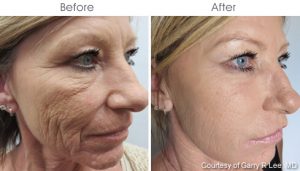
Credit: sharongiesemd.com
Frequently Asked Questions
What Is Microneedling?
Microneedling is a cosmetic procedure. It uses tiny needles to create micro-injuries in the skin. This promotes collagen production.
Does Microneedling Help Tighten Skin?
Yes, microneedling can help tighten skin. It stimulates collagen and elastin production, which improves skin firmness.
How Often Should You Do Microneedling?
For best results, microneedling is recommended every 4-6 weeks. Consult a dermatologist for a personalized plan.
Is Microneedling Safe For All Skin Types?
Microneedling is generally safe for all skin types. However, it’s best to consult a dermatologist before starting treatment.
Conclusion
Microneedling can help tighten skin. It boosts collagen production. This makes your skin look firmer and younger. Many people see results after a few treatments. It is a popular choice for those seeking a non-surgical option. Always consult a professional before starting any treatment.
Proper care after microneedling is important. Your skin will thank you. Try it if you want to improve your skin’s texture.

